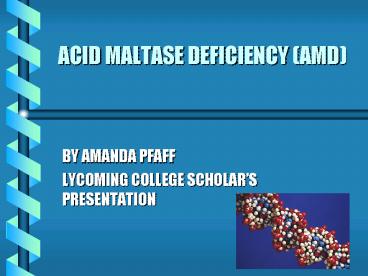ACID MALTASE DEFICIENCY AMD - PowerPoint PPT Presentation
1 / 26
Title:
ACID MALTASE DEFICIENCY AMD
Description:
Acid maltase deficiency is a heterogeneous autosomal recessive disease caused by ... Bhavin Desai. Kimberly Bunting. Lycoming College Scholar's Council ... – PowerPoint PPT presentation
Number of Views:261
Avg rating:3.0/5.0
Title: ACID MALTASE DEFICIENCY AMD
1
ACID MALTASE DEFICIENCY (AMD)
- BY AMANDA PFAFF
- LYCOMING COLLEGE SCHOLARS PRESENTATION
2
ACID MALTASE DEFICIENCY also known as
- Glycogen Storage Disease Type II
- Type II Glycogenosis
- Pompes Disease
3
DEFINITION OF AMD...
- Acid maltase deficiency is a heterogeneous
autosomal recessive disease caused by a
deficiency of lysosomal alpha-glucosidase,
leading to a characteristic accumulation of
glycogen in lysosomes.
4
Terms with which we must be familiar...
- Heterogeneous
- Autosomal
- Recessive
- Lysosome
5
HISTORY OF AMD
- In 1932, Pompe and Putschar first described AMD
in infants. - Engel and Dale subsequently described the later
onset or adult form of AMD - In 1959, Sant Agnese described the diagnostic
criteria for infantile AMD. - In 1963, Hers discovered the primary deficiency
of lysosomal acid alpha-glucosidase.
6
INTERESTING FACTS ABOUT AMD...
- AMD is not confined to the human species
- also occurs in the Lapland dog
- in cats, sheep, and cattle
7
OTHER FACTS ABOUT AMD...
- The severity of AMD is largely correlated with
residual acid alpha-glucosidase activity. - People with AMD have at least one deleterious
mutation in each of their 2 alpha-glucosidase
alleles - leads to a partial or complete loss of the enzyme
protein and/or catalytic function
8
ACID MALTASE ENZYME
- Acid maltase (or acid alpha-glucosidase) degrades
glycogen in the lysosomes and free tissue. - Acid maltase also hydrolyzes alpha 1-4 and 1-6
glycosidic linkages in maltose, isomaltose, and
glycogen.
9
THE STRUCTURE OF GLYCOGEN
10
GLYCOGEN
- Resides primarily in the muscle tissue.
- It is an important fuel for muscles, especially
type II muscle fibers. - Its most important function is glycolysis.
- Under anaerobic conditions, glycogen is the main
energy source for muscle contraction.
11
HOW DOES GLYCOGEN GET INTO THE LYSOSOMES?
- Most cell types self-digest parts of cells as a
normal lysosomal function. - As a result, glycogen and other cell components
get into the lysosomes.
12
NORMAL ACID MALTASE FUNCTION
- In people not affected with AMD, acid maltase
breaks down glycogen in the lysosomes.
13
ACID MALTASE FUNCTION IN AMD
- Reduced activity of acid maltase.
- Leads to abnormal accumulation of glycogen in the
lysosomes, skeletal muscle, and free tissues.
14
GENETICS OF AMD
- The acid maltase gene (GAA gene) is located on
the q arm of chromosome 17. - The GAA gene contains 20 exons and is
approximately 20 kilobases long.
15
COMMON MUTATIONS IN AMD
- The 3 types of mutations that occur in patients
with AMD are missense, nonsense, and frameshift. - 3 common mutations of the GAA gene are
- deletion of exon 18 (Dexon 18)
- a single base pair deletion (DT525)
- a base substitution in intron 1 (-13T to G)
16
DELETION OF EXON 18
- Dexon 18 is the most frequent mutation in AMD
with an incidence of 10 in 78 alleles (0.13
frequency). - It is not restricted to certain phenotypes, but
it is more frequent in Dutch populations. - A patient homozygous for Dexon 18 has the
infantile form of AMD with no acid maltase
activity. - Dexon 18 paired with the base substitution (-13T
to G) manifests the juvenile or adult form o fAMD
with 10-20 acid maltase activity.
17
SINGLE BASE PAIR DELETION DT525
- The DT525 occurs in exon 2.
- DT525 is also a common mutation within the Dutch
population. - Homozygotes for DT525 present the infantile form
of AMD with complete deficiency of acid maltase.
18
BASE SUBSTITUTION IVS1 (-13T TO G)
- The IVS1 (-13T to G) mutation is frequent among
adults with AMD, but it is not found in the
infantile form. - IVS1 (-13T to G) is a mild mutation
- it allows acid maltase synthesis and function at
20-40 of the normal level.
19
THREE CLINICAL FORMS OF AMD
- The 3 different phenotypes of AMD are related to
the different mutations in the acid maltase gene. - Infantile Juvenile
Adult
20
INFANTILE FORM OF AMD
- Shortly after birth, the infant develops severe
hypotonia. - Enlargement of the heart, liver, and tongue
occurs due to massive glycogen accumulation. - There is marked limb weakness with a reduction of
acid maltase levels in the muscle. - Rapid progression of the disease leads to death
before 2 years of age, usually due to cardiac or
respiratory failure.
21
JUVENILE FORM OF AMD
- Symptoms begin in infancy or early childhood, but
the decline is much slower. - AMD is restricted to skeletal muscle with no
cardiac involvement. - Weakness of trunk and proximal limbs is slowly
progressive. - Patients can survive for many years, but death
due to respiratory failure usually occurs before
age 30.
22
ADULT FORM OF AMD
- Symptoms usually begin in the thirties or
forties. - The first symptom is weakness of the limb and
girdle muscles with slow deterioration. - As with the juvenile form, there is no cardiac
involvement. - Death from respiratory failure occurs years after
onset.
23
TREATING AMD
- Mobilizing glycogen in tissues
through epinephrine injections. - Mobilizing glycogen with ephedrine and glucagon.
- Administering oral acid maltase prepared from
bacteria and human placenta. - Limiting carbohydrate intake.
24
DIAGNOSING AMD
- Diagnosis requires laboratory studies of acid
maltase levels in - muscle, lymphocytes, fibroblasts, and urine
- Muscle biopsies and skin biopsies are also
performed.
25
The End
26
THANK YOU...
- Dr. Gabriel--project supervisor
- Bhavin Desai
- Kimberly Bunting
- Lycoming College Scholars Council































